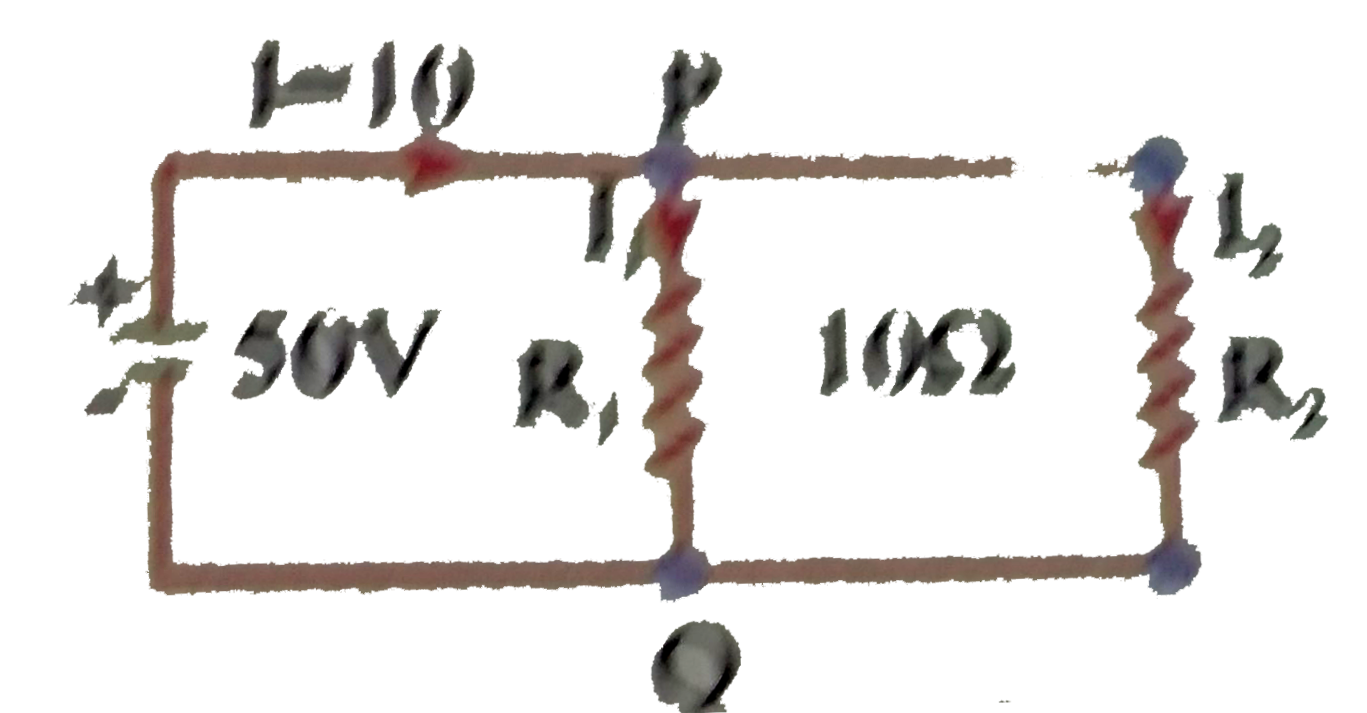In Fig.6.66, voltmeter is not ideal. If the voltmeter is removed from R1 and then put across R2, what will be the effect on current I? Given
R1>R2.

decreases
remains same
increases
I would have been same if voltmeters were ideal.
The correct Answer is:A, D
Let resistance of voltmeter be RV. Then the equivalent resistance of circuit is
Req=R2+R1RVR1+RV=R1R2+R2RV+RVR1R1+RV
I=EReq=E(R1+RV)R1R2+R2RV+RVR1
On putting voltmeter across R2, we can get current
I'=E(R1+RV)R1R2+R2RV+RVR1 as R1>R2⇒I>I'
If voltmeter is ideal, then in both cases R1 and R2 will be in series and current in both ceses will be I=E/(R1+R2).
Topper's Solved these Questions
- BOOK - CENGAGE PHYSICSCHAPTER - ELECTRICAL MEASURING INSTRUMENTSEXERCISE - Assertion-Reasoning7videos
ELECTRICAL MEASURING INSTRUMENTS
- BOOK - CENGAGE PHYSICSCHAPTER - ELECTRICAL MEASURING INSTRUMENTSEXERCISE - Comprehansion15videos
ELECTRICAL MEASURING INSTRUMENTS
- BOOK - CENGAGE PHYSICSCHAPTER - ELECTRICAL MEASURING INSTRUMENTSEXERCISE - Single Correct94videos
ELECTRICAL MEASURING INSTRUMENTS
- BOOK - CENGAGE PHYSICSCHAPTER - ELECTRIC POTENTIALEXERCISE - DPP 3.514videos
ELECTRIC POTENTIAL
- BOOK - CENGAGE PHYSICSCHAPTER - ELECTROMAGENTIC INDUCTIONEXERCISE - QUESTION BANK40videos
ELECTROMAGENTIC INDUCTION
Similar Questions
In the circuit shown in the figure, two resistors R1andR2 have been connected in series to an ideal cell. When a voltmeter is connected across R1 its reading is V1=4.0 volt and when the same voltmeter is connected across R2 its reading is V2=6.0 volt. The reading of the voltmeter when it is connected across the cell is V3=12.0 volt. Find the actual across R1 in the circuit.
 View Solution
View SolutionThree resistors R1=3kΩ,R2=2kΩandR3=5kΩ have been connected to a constant current source as shown in figure. The current source supplies current I=2mA to the circuit. A voltmeter with RV=6kΩ internal resistance is connected, as shown, to measure the potential difference across R1.
(a) Find the percentage error in the measurement of potential difference (V1) across. R1 caused due to finite resistance of the voltmeter.
(b) If positions of R2andR3 are interchanged will the percentage error in measurement of V1 increase or decrease ?
 View Solution
View Solution
Knowledge Check
- Question 1 - Select One
In the given circuit if I1 and I2 be the current in resistance R1 and R2 respectively then:
 AI1=3A,I2=2ABI1=0,I2=2ACI1=2A,I2=2ADI1=2A and I2 can’t be determined with given data
AI1=3A,I2=2ABI1=0,I2=2ACI1=2A,I2=2ADI1=2A and I2 can’t be determined with given data - Question 2 - Select One
Two ideal batteries of emfV1andV2 and three resistance R1R2andR3 are connected The current in resistance R2 would be zero if
 AV1=V2andR1=R2=R3BV1=V2andR1=2R2=R3CV1=2V2and2R1=2R2=R3D2V1=V2and2R1=R2=R3
AV1=V2andR1=R2=R3BV1=V2andR1=2R2=R3CV1=2V2and2R1=2R2=R3D2V1=V2and2R1=R2=R3 - Question 3 - Select One
In the following figure, the reading of an ideal voltmeter V is zero. Then, the relation between R, r1 and r2 is
 AR=r2−r1BR=r1−r2CR=r1+r2DR=r1r2r1+r2
AR=r2−r1BR=r1−r2CR=r1+r2DR=r1r2r1+r2
In the given circuit the internal resistance of the 18 V cell is negligible. If R1=400Ω and the reading of an ideal voltmeter across R4 is 5V, then the value of R2 will be :
 View Solution
View SolutionResistance of a milli ammeter is R1 of an ammeter is R2 of a voltmeter is R3 and of a kilovoltmeter is R4. Find the correct order of R1,R2,R3 and R4.
View SolutionFor a circuit shown in fig find the value of resistance R2 and current I2 flowing thorugh R2
 View Solution
View SolutionIn parallel combination, the effective resistance (of R1 and R2) is given by
View SolutionA galvanometer is to be converted into a voltmeter and an ammeter successively by using either of two resistances R1andR2(R1>R2)
View Solution

